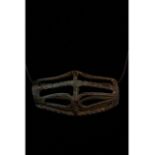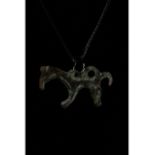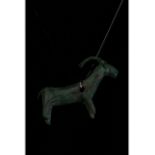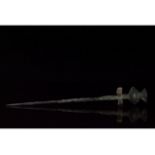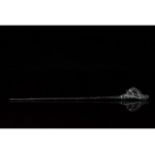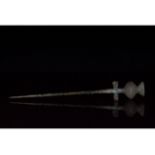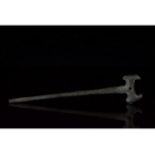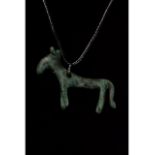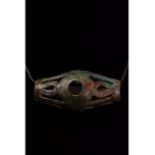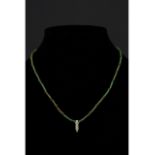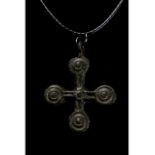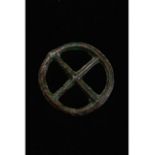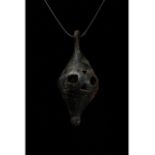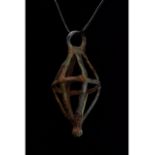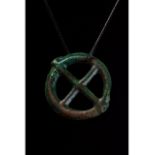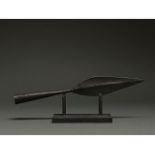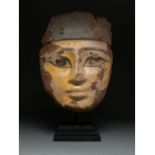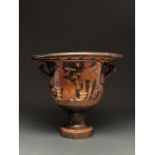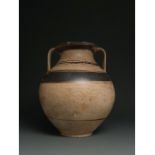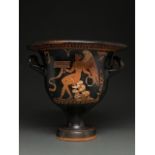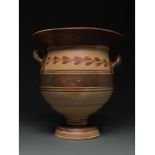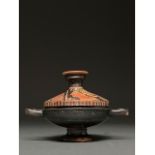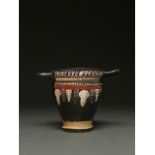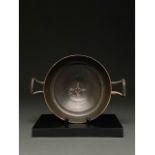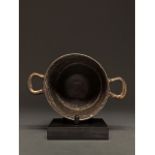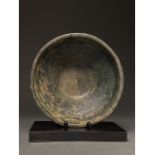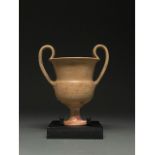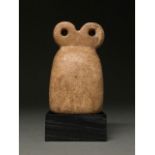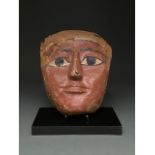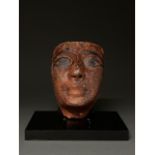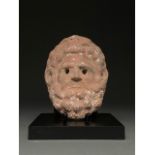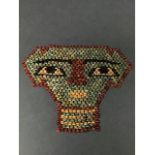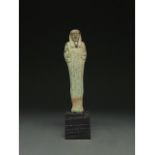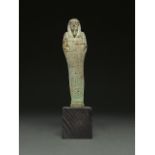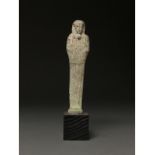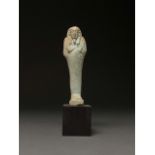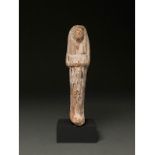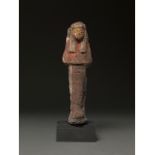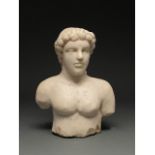Filtered by:
- Category,
- Item Type
- List
- Grid
A subscription to the Price Guide is required to view results for auctions ten days or older. Click here for more information
BRONZE AGE "CAGE" PENDANT
C. 600 BC, Bronze Age Large bronze cage pendant. The pendant's openwork biconical shape is formed of a combination straight and curved bars of bro...
BRONZE AGE ANIMAL AMULET
C. 600-800 BC. Bronze Age. Cast bronze zoomorphic amulet comprising an animal, perhaps a horse, shown in profile, with dual circular suspension lo...
BRONZE AGE RAM AMULET
C. 1000 BC. Hallstatt Culture. Cast bronze zoomorphic amulet in the form of a ram with short snout, long curving horns, clearly delineated legs an...
BRONZE AGE LURISTAN DRESS PIN
Ca.1300-600 BC. Bronze Age Luristani culture. Bronze cloth pin comprising a round-sectioned shank and stylised poppy-head terminal above a cross-s...
Ca.1300-600 BC. Bronze Age Luristani culture. Bronze cloth pin comprising a round-sectioned shank and stylised rams-head terminal. Good condition;...
BRONZE AGE LURISTAN DRESS PIN
Ca.1300-600 BC. Bronze Age Luristani culture. Bronze cloth pin comprising a round-sectioned shank, and stylised poppy-head terminal above a cross-...
Ca.1300-600 BC. Bronze Age Luristani culture. Bronze cloth pin comprising a round-sectioned shank and double stylised rams-head terminal. Good con...
C. 1000 BC. Hallstatt Culture. Cast bronze zoomorphic amulet in the form of a horse in a resting position; the beast features clearly defined limb...
C. 600 BC, Bronze Age Large bronze cage pendant. The pendant's openwork biconical shape is formed of a combination straight and curved, and circul...
712-30 BC, Late Period/Ptolemaic. A beautiful restrung necklace comprising multi-coloured discoid and tubular faience beads as well as a blue faie...
MEDIEVAL BRONZE CROSS PENDANT
C. 1000 AD. Medieval Saxon period. Bronze cross with four equal-length arms with ribbed decoration. The centre of the cross and each of the ends o...
BRONZE AGE WHEEL PENDANT
Ca. 600 BC. Bronze Age. Bronze age wheel pendant comprising circular hoop and crossed spokes. In ancient societies, wheel amulets were traditional...
BRONZE AGE CAGE SHAPED PENDANT
C. 600 BC, Bronze Age Large bronze cage pendant. The pendant's biconical shape is formed of a single sheet of bronze with small sections removed t...
BRONZE AGE CAGE PENDANT
C. 600 BC, Bronze Age. Large bronze cage pendant. The pendant's openwork biconical shape is formed of a combination straight and curved bars of br...
BRONZE AGE WHEEL PENDANT
Ca. 600 BC. Bronze Age. Bronze age wheel pendant comprising circular hoop and crossed spokes. In ancient societies, wheel amulets were traditional...
c. 200 BC. Celtic Iron Age. Large iron spear comprising a pointed leaf-shaped blade with a prominent midrib and round, conical socket. Excellent c...
EGYPTAIN WOODEN SARCOPHAGUS MASK
664 – 343 B.C. Late Dynastic / Ptolemaic Egyptian. A beautiful wooden sarcophagus cover depicting an individual with a blue headpiece, golden sk...
C. 300 BC. Southern Italian. Beautiful red-figure bell crater with flaring rim, bell-shaped body, rounded stem, disc-shaped base and two lug handl...
600-200 BC. Apulia. Daunian pelike in a cream fabric with out-turned rim, neck flaring neck, piriform body and flattened base; two strap handles a...
C. 400-300 BC. South Italian. Red figure bell krater with flaring rim, bell-shaped body, rounded stem, disc-shaped base and two lug handles. Side ...
600-200 BC. Apulia. Daunian bell krater with flaring rim, bell-shaped body, rounded stem, disc-shaped base and two lug handles. The cream-coloured...
C. 300 BC. Southern Italian. Beautiful terracotta pyxis comprising lid and bowl. The lid comprises a disk-shaped handle and inverted conical body ...
400-300 BC. Southern Italian. Gnathian skyphos with deep, curved sides, ring foot and two equally spaced loop handles. The exterior is painted bla...
c. 300 BC. South Italian. Terracotta kylix, with hemispherical bowl, ring foot and two equally spaced loop handles; stamped vegetal decoration is ...
c. 300 BC. South Italian. Terracotta skypos, with deep, curved sides, ring foot and two equally spaced loop handles; stamped vegetal decoration is...
LARGE ETRUSCAN BRONZE BOWL
900-600 BC. Etruscan. Beautiful bronze bowl with out-turned rim, conical body, and flattened bottom. Rows of horizontal line decoration run around...
C. 400-300 BC. South Italian. Cream-coloured krater with large ear-shaped handle, out turned rim, bell-shaped body, round stem and ring foot. A kr...
Ca.4000 BC. Western Asiatic. Attractive brown stone Tell Brak Eye Idol consisting of a bell-shaped body supporting two drilled circular eyes. Idol...
EGYPTAIN WOODEN SARCOPHAGUS MASK
Ca.1070-945 BC Egyptian, Early Third Intermediate Period. A beautiful wooden sarcophagus cover depicting an individual with ochre-coloured skin, a...
EGYPTAIN WOODEN SARCOPHAGUS MASK
Ca.1070-945 BC Egyptian, Early Third Intermediate Period. A beautiful wooden sarcophagus cover depicting an individual with ochre-coloured skin, a...
ETRUSCAN TERRACOTTA MASK
600-900 BC. Etruscan. Terracotta mask of a male figure with long hair and full beard; the hairs are depicted in a stylised manner with individual ...
EGYPTIAN BEADED MUMMY MASK
664 – 343 B.C. Late Dynastic / Ptolemaic Egyptian. Beaded mummy mask made of delicate faience beads in green, yellow, black and red. The face is...
ANCIENT EGYPTIAN FAIENCE USHABTI
Ca.1070-945 BC Egyptian, Early Third Intermediate Period. Beautiful light blue faience ushabti figure wearing a tripartite wig and a false beard. ...
ANCIENT EGYPTIAN FAIENCE USHABTI
Ca.1070-945 BC Egyptian, Early Third Intermediate Period. Beautiful light blue faience ushabti figure wearing a tripartite wig and a false beard. ...
ANCIENT EGYPTIAN FAIENCE USHABTI
Ca.1070-945 BC Egyptian, Early Third Intermediate Period. Beautiful light blue faience ushabti figure wearing a tripartite wig and a false beard. ...
ANCIENT EGYPTIAN FAIENCE USHABTI
Ca.1070-945 BC Egyptian, Early Third Intermediate Period. Beautiful light blue faience ushabti figure wearing a tripartite wig and a false beard. ...
ANCIENT EGYPTIAN CERAMIC USHABTI
Ca.1070-945 BC Egyptian, Early Third Intermediate Period. Beautiful terracotta-coloured ceramic ushabti figure wearing a tripartite wig, a false b...
ANCIENT EGYPTIAN CERAMIC USHABTI
Ca.1070-945 BC Egyptian. Beautiful buff-coloured ceramic ushabti figure wearing a tripartite wig and robe and standing with crossed arms. The face...
100 AD or later. Roman-style. Rectangular Roman-style marble head and torso of a youth with two-tiered curling locks, simple, boyish features, a t...

